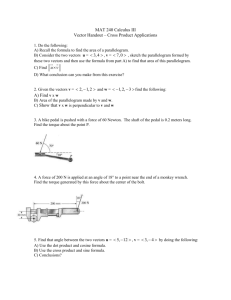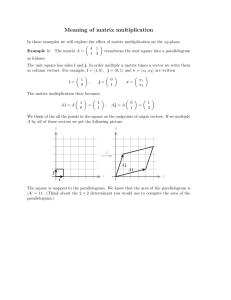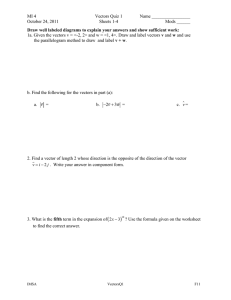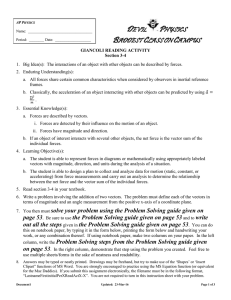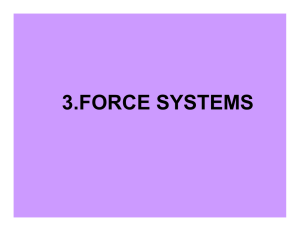Forces For next lecture:
advertisement
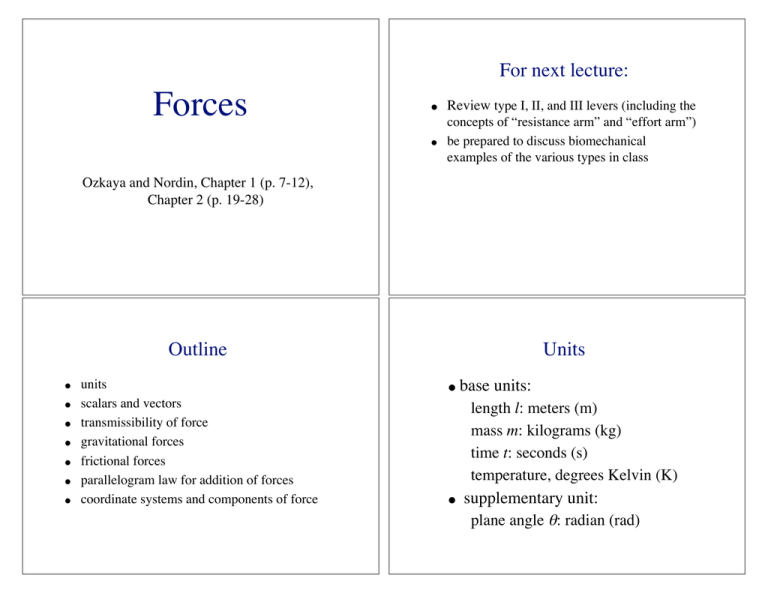
For next lecture: Forces ! Review type I, II, and III levers (including the ! concepts of “resistance arm” and “effort arm”) be prepared to discuss biomechanical examples of the various types in class Ozkaya and Nordin, Chapter 1 (p. 7-12), Chapter 2 (p. 19-28) Outline ! ! ! ! ! ! ! units scalars and vectors transmissibility of force gravitational forces frictional forces parallelogram law for addition of forces coordinate systems and components of force Units ! base units: length l: meters (m) mass m: kilograms (kg) time t: seconds (s) temperature, degrees Kelvin (K) ! supplementary unit: plane angle !: radian (rad) Derived units Unit conversions Multiply: ! lb by 4.45 to get N ! inches by 0.0254 to get m ! in·lb by ?? to get N·m? 1 [in·lb]·4.45 [N/lb] ·0.0254 [m/in] = 0.113 N·m Vectors and Scalars ! ! Scalars: variables defined by magnitude only (e.g., volume, temperature) Vectors: variables defined by magnitude and direction (e.g., force, velocity) v = 10 m s-1 30° NOTE: We will designate vectors with arrows in diagrams, and with boldface (r) or an arrow over the symbol (r ) in text. We will use italics (r) when referring to only the magnitude of a vector quantity. Forces are vectors ! force: push or pull that tends to cause motion of a body, or change the shape of a body F ! characteristics of a force: ! point of application ! magnitude ! direction (sense and line of action) ! Transmissibility Of Force Same equilibrium conditions, but different internal forces? The force acting on a rigid body can “slide” along it’s line of action, without changing the conditions of equilibrium or motion. r r Fr = W r W = mg = r W = mg r r Fr = W Gravitational forces ! ! ! gravitational force, or weight, is an attractive force of magnitude mg that the earth exerts on a body of mass m g = gravitational constant = 9.81 m/s2 example of a noncontact force Measuring force ! r W = mg r r Fr = W Force cannot be measured, only derived from other measures (e.g., deflection of a spring). deflection (units of m) F k "x F = k"x spring constant (units of N/m) Resolution of force into components Adding forces by summing components • i and j are unit vectors in the x and y direction, respectively. • Fx and Fy are magnitudes • Fx and Fy are vectors in x and y direction, respectively Force Addition (Parallelogram Law): ! Two forces acting on a particle may be replaced with a single resultant force, obtained by drawing the diagonal of a parallelogram which has sides equal to the given forces. Figure 1: two forces P and Q applied to particle A Figure 2: the resultant force R obtained graphically from the parallelogram rule Vectors add “Head to tail” Forces at knee joint during traction Vector Subtraction with the Parallelogram Law Figure 1: two forces P and Q Law of Sines and Law of Cosines Law of Cosines a 2 = b 2 + c 2 ! 2bc " cosA b 2 = a 2 + c 2 ! 2ac " cosB c 2 = a 2 + b 2 ! 2ab " cosC Law of Sines a b c = = sinA sinB sinC Where A, B, and C are the interior angles of a general triangle, and a, b, and c are lengths of the sides opposite those angles. Figure 2: the difference P-Q obtained graphically as P + (-Q) from the parallelogram law Coordinate systems Different coordinate systems exist to define the position of a point P in space: Cartesian: x, y, and z Cylindrical: r, !, and z Spherical: ", !, and # Coordinate Systems ! x = r cos ! y = r sin ! ! r = x2 + y2 ! # y& ! = tan "1 % ( $ x' Centre of pressure ! Equations of static equilibrium are used to determine location on surface of force plate where equivalent resultant force is applied (more on this two lectures from now) transducers that measure x, y, and z components of applied force and moment often embedded flush with the floor sample surface dimensions: 40 x 60 cm, 60 x 90 cm Vertical ground reaction forces during walking and running Vertical Force (BW) Converting between cartesian and polar: Force Platforms 3 Walk Run 2 1 0 0.0 0.1 0.2 0.3 0.4 Time (seconds) 0.5 0.6 0.7 Frictional Forces How much force must be applied to move an object? Frictional forces are tangential forces that resist sliding between contacting surfaces. W Fk = µ k N P Fm frictional force F Frictional forces can exist with or without movement (indeed they often act to prevent movement!) Fm=µsN N Fk Static equilibrium Motion applied tangential force P Review Questions ! ! ! ! ! ! what are the four base units in mechanics? what are the units of force? what is the difference between a vector and a scalar? how do you resolve vectors into their x- and y-components? how do you add vectors? what factors determine the ability of friction to resist movement? F Frictional force F equals applied tangential force P...up to a limit Fm Fm depends on: • coefficient of static friction µs • normal force N at interface
